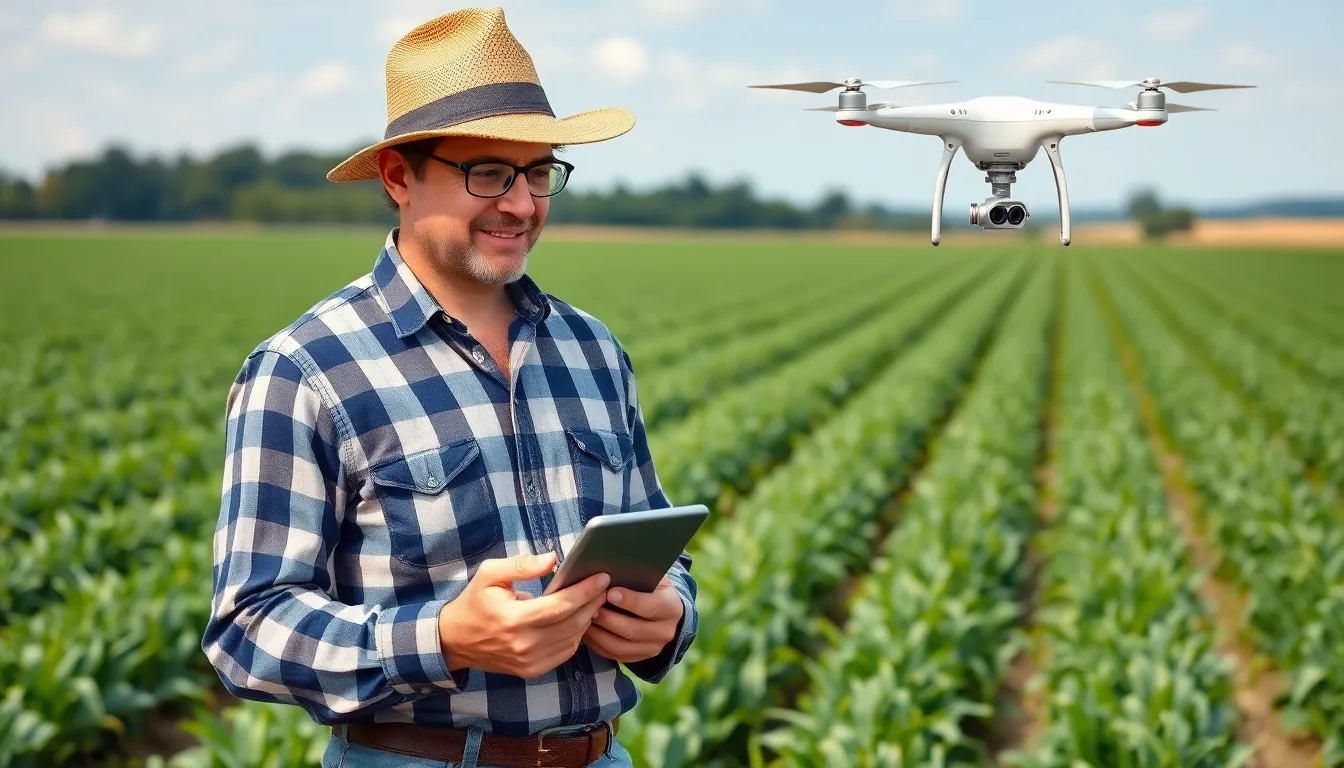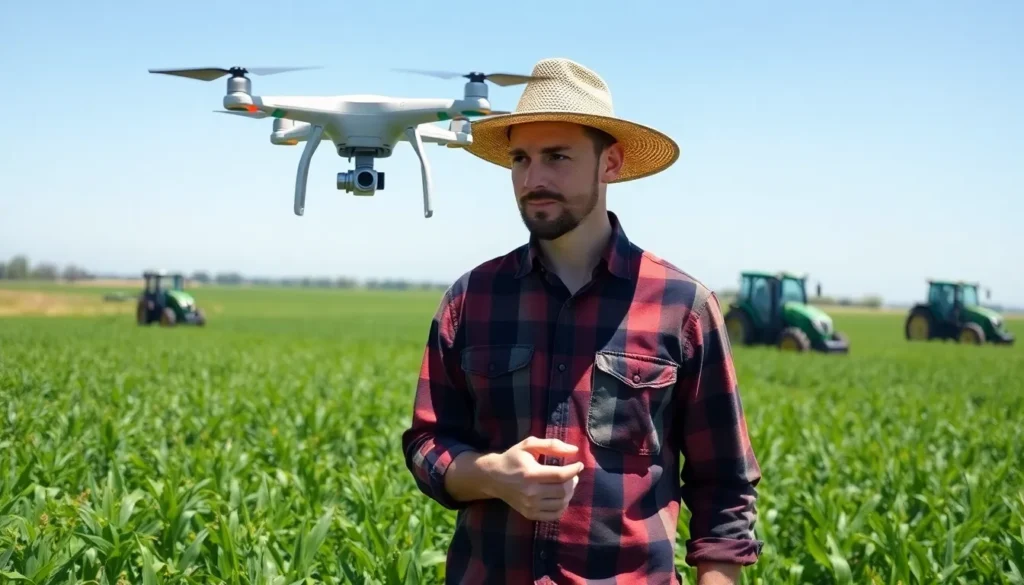Imagine a world where robots tend to crops, drones monitor fields, and data analytics help farmers make decisions faster than you can say “organic kale.” Emerging technologies in agriculture are transforming the way food is produced, making farming not just a way of life but a high-tech adventure. Gone are the days of back-breaking labor and guesswork; now it’s all about precision, efficiency, and maybe a little bit of magic.
Table of Contents
ToggleEmerging Technologies In Agriculture
Technologies such as robotics and automation are reshaping agricultural practices. Robots assist with tasks like planting and harvesting, enhancing efficiency and reducing labor costs. Drones play a crucial role in crop monitoring and management. These aerial devices provide real-time data on plant health and soil conditions, enabling farmers to make informed decisions.
Data analytics is transforming how farmers approach crop management. Using data-driven insights, they optimize irrigation schedules and fertilizer applications. Farm management software integrates various data points to improve overall productivity. Such systems help identify trends and forecast yield outcomes with greater accuracy.
Artificial intelligence (AI) is another emerging technology making waves in agriculture. It analyzes massive datasets to predict pest infestations or disease outbreaks. Farmers can respond proactively, protecting their crops and ensuring higher yields. Machine learning algorithms also refine planting strategies by evaluating historical data and environmental factors.
Biotechnology continues to evolve, creating genetically modified organisms (GMOs) that exhibit improved resistance to pests and diseases. These advancements lead to higher productivity and lower chemical inputs, making farming more sustainable. Precision agriculture employs sensor technology to monitor field variability, allowing targeted interventions.
Overall, emerging technologies in agriculture foster a transition toward more sustainable practices. With tools that enhance productivity, increase efficiency, and reduce environmental impact, modern farming embraces innovation. As these technologies advance, they promise to further optimize the agriculture sector, paving the way for a more food-secure future.
Precision Farming

Precision farming revolutionizes agriculture through technology that enhances crop management and resource efficiency. This approach leverages data to optimize yields and minimize waste.
Benefits of Precision Agriculture
Precision agriculture offers numerous advantages. Increased crop yields occur through optimized resource application. Farmers experience reduced costs by minimizing inputs like water, fertilizers, and pesticides. Improved environmental sustainability results from using fewer chemical inputs. Enhanced decision-making is possible with real-time data that helps identify optimal planting and harvesting times. Greater profitability emerges as precision farming leads to improved operational efficiency.
Tools and Techniques
Several tools and techniques drive precision agriculture. GPS technology enables accurate field mapping and position tracking. Remote sensing tools include drones and satellites that monitor crop health and soil conditions. Soil sensors provide real-time data on moisture levels, allowing targeted irrigation. Farm management software integrates data analytics, aiding in crop planning and yield forecasting. Robotics and automation streamline planting, weeding, and harvesting processes, increasing efficiency. AI and machine learning contribute predictive analytics, enhancing pest and disease management. These tools collectively foster efficient, sustainable farming practices.
Biotechnology Innovations
Biotechnology plays a crucial role in enhancing agricultural practices. Innovations in this field, notably through GMOs and CRISPR technology, contribute to sustainable farming and increased food security.
Genetically Modified Organisms (GMOs)
Genetically modified organisms significantly improve crop resilience. They enable plants to withstand pests and diseases more effectively. Research shows that GMOs can lead to increased yields, reducing the need for chemical pesticides. Farmers adopting these crops experience lower production costs. For instance, Bt corn has been engineered to express a toxin that deters specific insect pests, resulting in higher harvests. Adoption of GMOs also promotes environmental sustainability by decreasing reliance on traditional agricultural inputs.
CRISPR Technology
CRISPR technology offers precise gene-editing capabilities. This method allows scientists to modify crops at the DNA level, enhancing desired traits quickly and efficiently. Altering specific genes can lead to increased disease resistance and improved nutritional profiles. The ability to edit genes without introducing foreign DNA simplifies regulatory processes. For example, research on CRISPR has produced wheat varieties resistant to fungal diseases, thereby reducing crop losses. As CRISPR matures, its influence on crop improvement will likely reshape agricultural productivity strategies.
Automation and Robotics
Automation and robotics significantly enhance modern agriculture, leading to increased efficiency and productivity. Innovations like drones and autonomous tractors are reshaping traditional farming methods.
Drones in Agriculture
Drones play a pivotal role in precision agriculture. They capture high-resolution images of fields, allowing farmers to monitor crop health in real-time. Detailed aerial imagery reveals critical insights into soil conditions and moisture levels. Farmers utilize this information to make informed decisions, optimizing resource allocation. Drones also assist in spraying fertilizers and pesticides, reducing chemical use and labor costs. With adjustments in flight paths and altitudes, drone technology maximizes crop output while minimizing environmental impact.
Autonomous Tractors
Autonomous tractors are revolutionizing fieldwork processes. Equipped with advanced sensors and GPS technology, these tractors perform tasks like plowing and planting without human intervention. High accuracy ensures optimal planting depth and spacing, enhancing crop yields. They operate continuously, increasing productivity while reducing labor dependency. Farmers program the tractors to follow specific routes, allowing for efficient movement across vast fields. Additionally, data collected by autonomous tractors contributes to better soil management and crop monitoring, ultimately streamlining agricultural operations.
Data Analytics and AI
Data analytics and artificial intelligence are reshaping agriculture through innovative technologies. They offer valuable insights that lead to more informed decisions.
Predictive Analytics
Predictive analytics utilizes historical data and statistical algorithms to forecast future outcomes in agriculture. For instance, it can project crop yields based on weather patterns, soil quality, and management practices. By applying these forecasts, farmers can optimize their planting schedules and resource allocations. Crop positioning and rotation strategies also improve with these insights, enhancing productivity. Moreover, predictive models aid in managing supply chains effectively, ensuring crops reach markets at peak quality.
Machine Learning Applications
Machine learning plays a pivotal role in processing vast amounts of agricultural data. Real-time data from sensors and machinery greatly enhances crop management practices. Advanced algorithms detect patterns in soil health, pest behavior, and environmental changes. Farmers receive tailored recommendations for irrigation and fertilization based on machine learning analyses. Additionally, these applications help identify disease outbreaks early, allowing for timely interventions. Yield predictions become more accurate as machine learning continues to evolve, promoting efficiency in agricultural operations.
Emerging technologies are reshaping the agricultural landscape in ways previously thought impossible. As farmers embrace innovations like robotics drones and data analytics they’re not just improving efficiency but also ensuring sustainability. This shift towards precision farming allows for better resource management and higher crop yields while minimizing environmental impact.
The integration of AI and biotechnology further enhances resilience against pests and diseases paving the way for a more secure food supply. With these advancements agriculture is entering a new era where technology and nature work hand in hand to meet global demands. As these technologies continue to evolve they promise to transform agriculture into a more efficient and sustainable industry for future generations.






